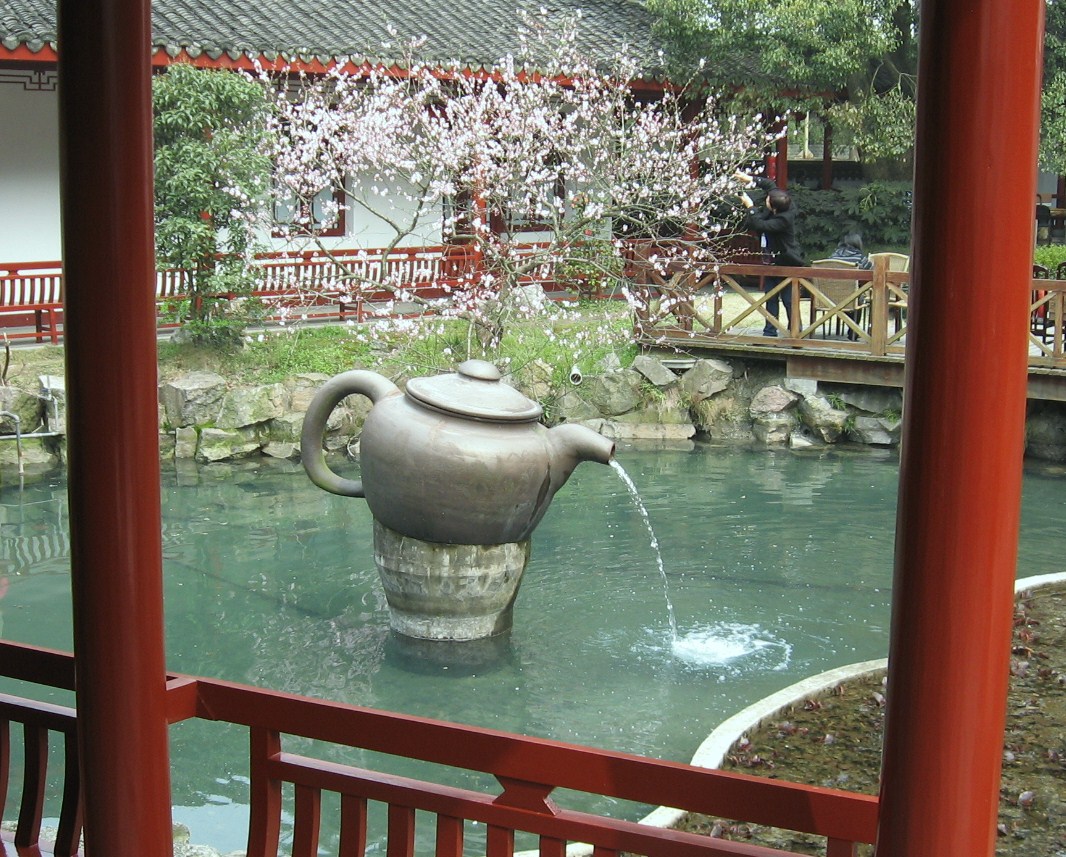
Since we’ve focused this month on recipes inspired by cuisine from the continent of Asia (I know, we never said there was a theme, but there was. We’re wily like that.), I thought tea would make another good subject for another research-based (some might say “nerdy”) post. Tea is the second most popular drink in the world. In the world, people — second only to water. I know I’m part of that statistic. I was only an occasional tea drinker until graduate school. You know what’s colder than a New England winter? A Pacific Northwest winter. I know, the thermometer says it’s warmer, but it’s wet and sinks into your bones. So you drink hot beverages — coffee, hot chocolate, and TEA.
And why not? Tea, at its root, is an easy drink to make — pour hot water over some leaves. It works with a variety of leaves, in fact, giving us tea (leaves from the camellia sinesis plant) and tisanes, which are commonly called “herbal teas” in the US.

I would guess that most people drink tea because they like the taste — and there are so many varieties that I imagine nearly anyone can find something that they enjoy. But tea has been used for centuries as part of Traditional Chinese Medicine, and Western medicine is now studying the potential health benefits of tea. One meta-study (review of all the other studies to gather the data in a single place for analysis) assembled the following list of tea’s benefits:
Recent human studies suggest that green tea may contribute to a reduction in the risk of cardiovascular disease and some forms of cancer, as well as to the promotion of oral health and other physiological functions such as anti-hypertensive effect, body weight control, antibacterial and antivirasic activity, solar ultraviolet protection, bone mineral density increase, anti-fibrotic properties, and neuroprotective power.
But what IS tea? Tea is the leaves or leaf buds of the camellia sinesis plant, which, left to its own devices becomes a tree, but is generally kept pruned to about waist-height for ease of harvesting. Tea is harvested by hand, with the leaves being picked every few weeks. The earliest harvests are generally the most prized, and different seasons produce different teas.
In 2009, I took a trip to China, and we visited a tea plantation near Suzhou, site of all the photos I’ve punched into this post. At the plantation, we were ushered into a lovely building, with a courtyard teapot fountain (top photo) and a tea tasting room that looked out over the bushes. All the tea here is picked by hand and processed (dried) on site. They produced 4 grades of tea, and the top two (Empress and Grade A) are never exported. Quality tea leaves like these can be re-used up to 5 times, so about all day.
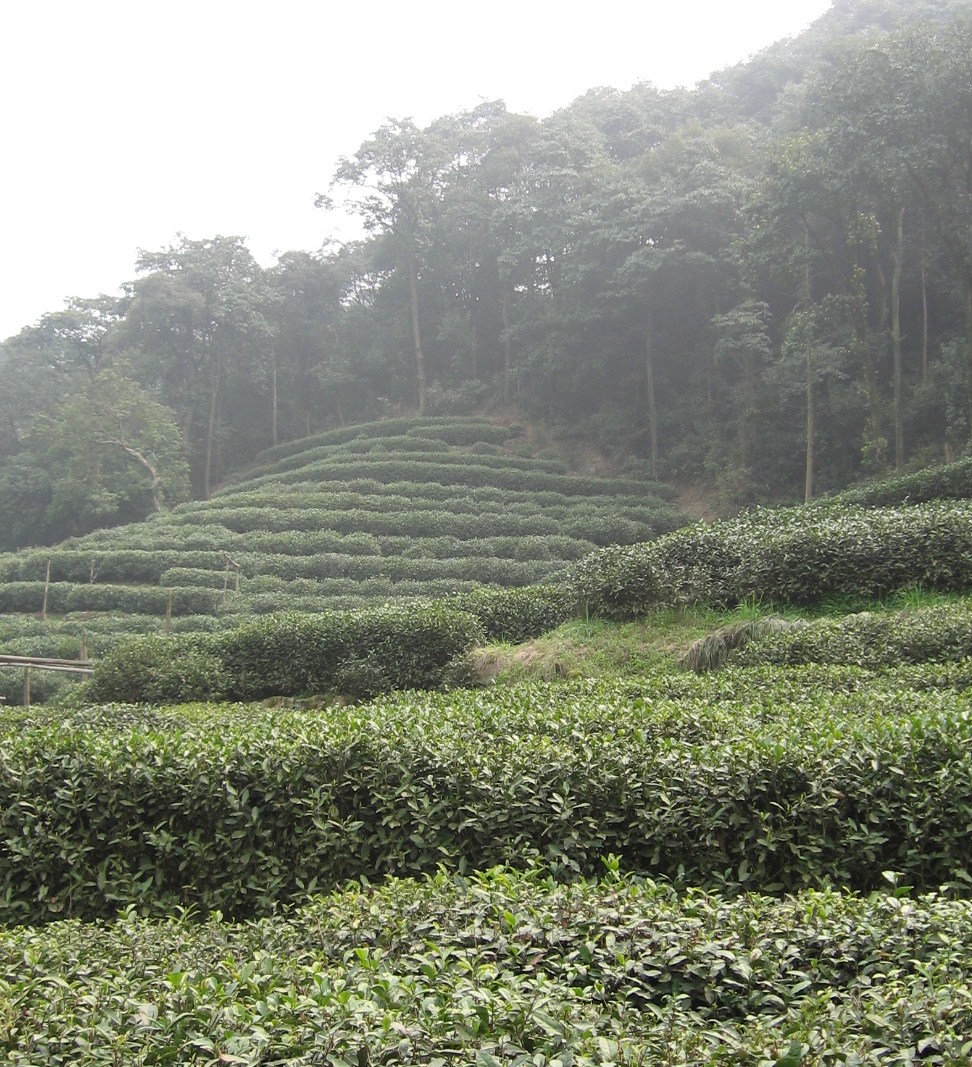
Tea is native to China, and the Chinese drink their tea green — unoxidized. Tea was oxidized and compressed for trade, but the Chinese traders considered this an inferior version of the drink. Tea hit a cultural high point during the Tang Dynasty (618-907 CE), when it was used for social ceremonies as well as in Buddhist ceremonies. Lu Yu wrote what may be the first tea manifesto, in which tea appreciation, using Taoist and Buddhist principles, could enhance one’s life — help you live your philosophy, and enjoy the moment. To this end, specialized tea wares, including ceramics, began to be developed Japanese Buddhist monks studying in China at this time discovered tea and its ceremonies, which they brought back to Japan.
As Japan’s tea culture flourished, the Manchu or Qing Dynasty in China changed the ethnicity and dominant traditions of the ruling classes. The Manchu were the primary market for the “inferior” oxidized teas that earlier Chinese dynasties traded at the borders — the precursor to what we know as black tea. They drank their tea dark, strong and with milk — fermented mare’s milk. This is the tea culture that the British Empire first encountered, and explains the popularity of black tea with milk as tea spread to Europe.

Tea spread first to Europe, and then to England, which is how it becomes part of the story of the US. The first sale of tea in London was in 1658, and tea became a fixture of British life when Charles II married Portuguese Princess Catherine of Braganza, a tea drinker. Chinese tea was traded through the Dutch, who had a monopoly on tea, and even when the Chinese began to trade directly with British merchants, it wasn’t enough. Tea was popular everywhere, including in the British colonies, including the one Denise and I both live in now.
The 1773 Boston Tea Party, besides being an important historical landmark event, seems to be a high point for high school history, given how well it is remembered (I vaguely remember a re-enactment class, and I grew up in the South. If you ever get a chance, go to the Old South Meeting House re-enactment in Boston — it’s worth the trip.) The really short version? The colonists were tired of being taxed by the British, and began to boycott their imports. The Dutch were more than happy to sell their tea without a tax, so to undercut them, the British decided to empty some warehouses of tea at low cost to the colonists. The colonists? Didn’t take the bait. They asked the governor to send the three ships back to England without unloading. When the governor refused, the Sons of Liberty, dressed as Native Americans, boarded the ships and dumped the tea overboard.
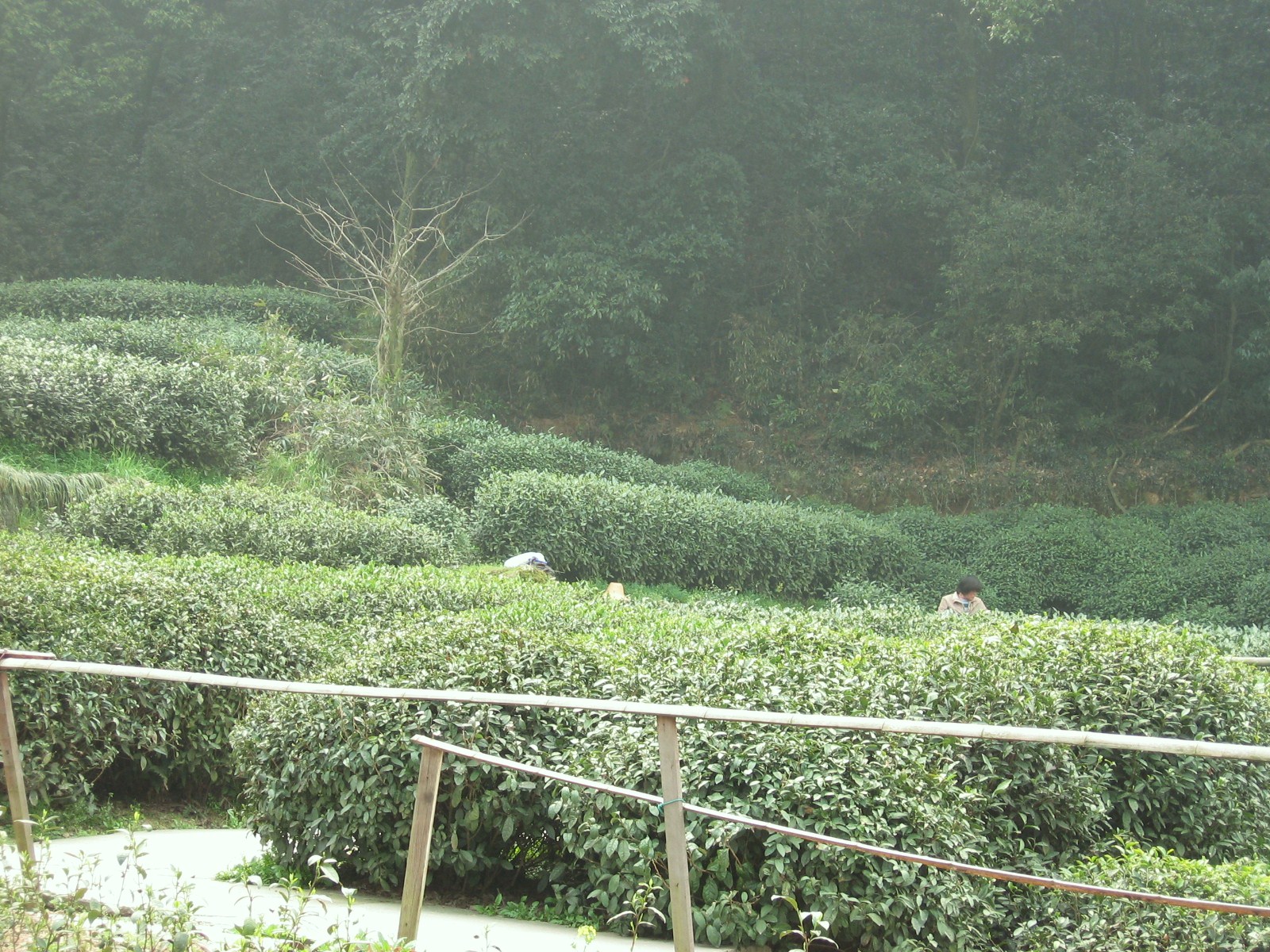
Tea was also the beginning (and end result) of another war — the Opium Wars of 1839-1842 in which British traders tried to make back the money they paid the Chinese for tea by importing Indian opium into China. China lost, and badly, not only paying for the war, but giving Hong Kong to the British. Remember when Hong Kong was “repatriated,” if that’s the right term? In 1997? All over TEA.
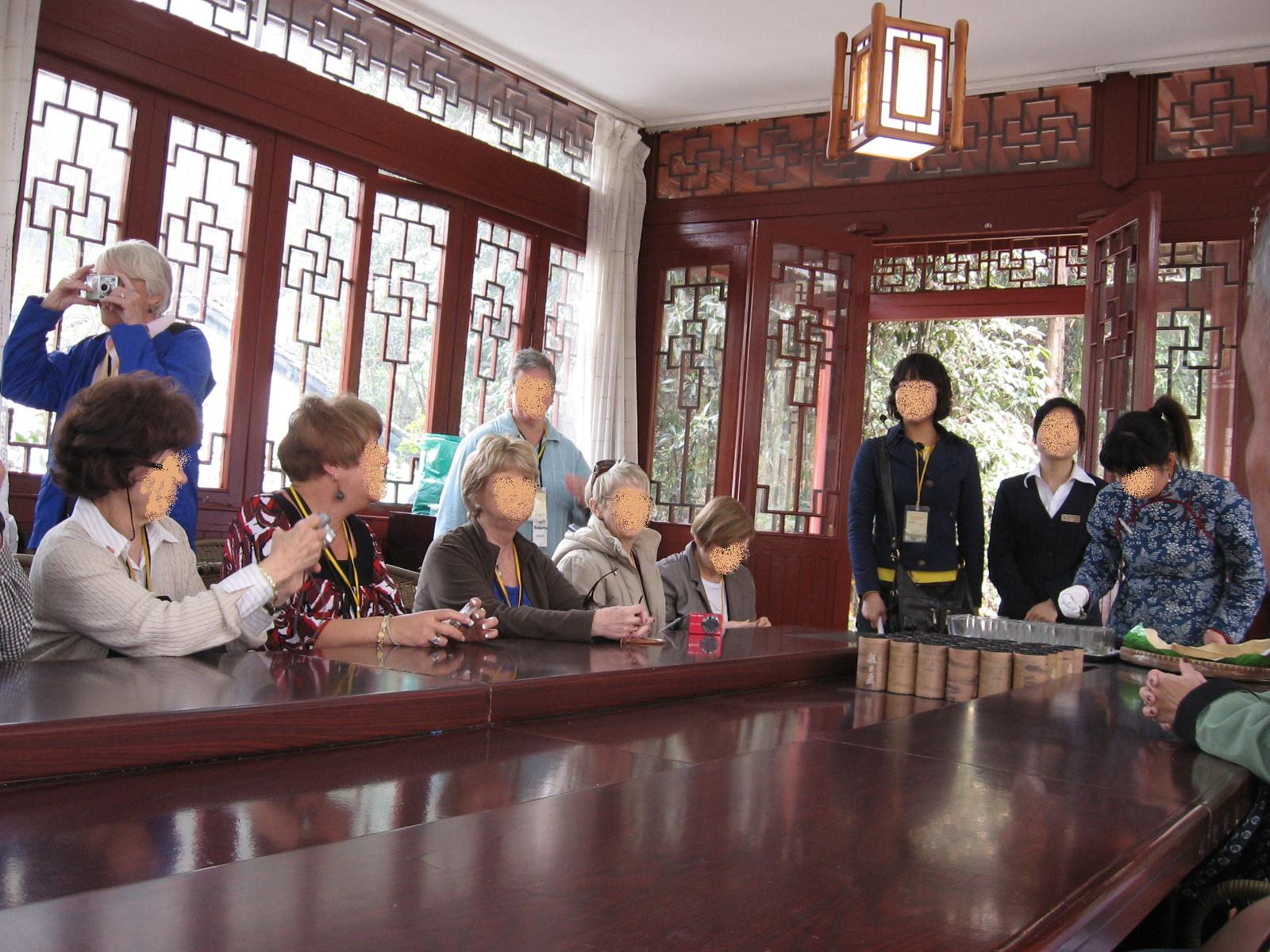
Please ignore the blurred faces– none of these people asked to be on the internets.
As part of the great sales pitch at the tea tasting room in Suzhou, we were given tea to taste, but also demonstrations of green tea’s detoxifying power — but wait, it also absorbs fat! And this dirt in the water! According to my journal notes, green tea steam can be a great eye moisturizer (I had forgotten all this, but allergy season is a great time to test it out), and green tea bags can be used to absorb fat in a soup stock (I never tried this either, but there’s no time like the present).
Fresh tea leaves contain about 4% caffeine, and scientists have speculated that it may be a chemical defense system for the plant. Tea also contains flavinoids, vitamins, and polysaccharides, as well as amino acids. One of these amino acids is L-Theanine, an amino acid that naturopaths say stress depletes in your body, but which provides a calm, alert, and focused mental state. I want a calm, alert, and focused mental state, don’t you? That may be why I drink so much tea.
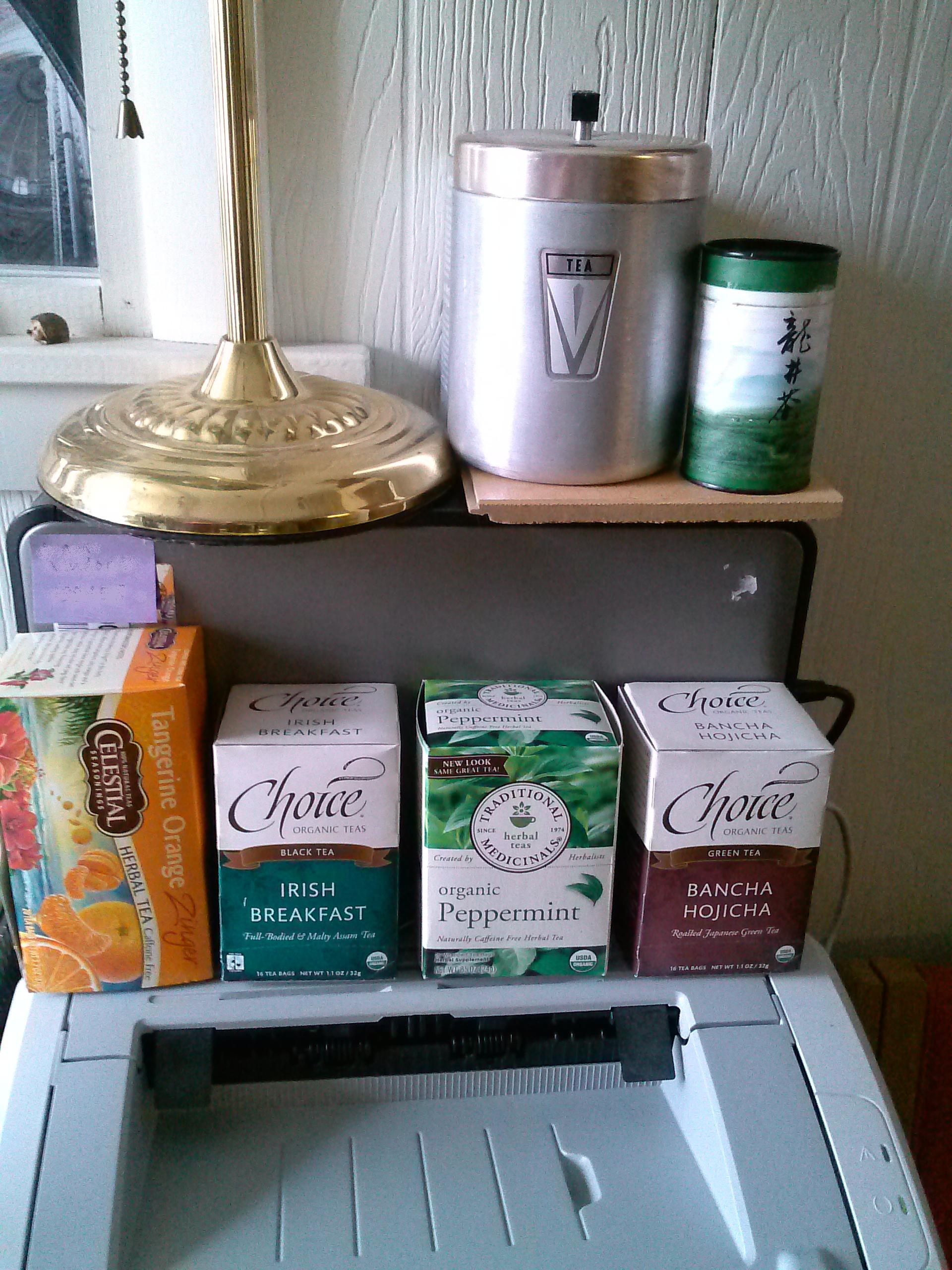
Given all this, what teas do I drink? I admit that, lovely as loose tea is, it’s not my go-to tea method. I usually have tea bags in my purse (always) or carry-on bag (when flying). The photo above is just my collection of teas at work, where they take up valuable real estate on the printer. The small green canister up there was the last bit of tea from my trip to China, and the aluminum canister holds all the many assorted teas and tisanes I’ve collected over time. The boxes include two tisanes — a Celestial Seasonings Tangerine Zinger and a peppermint, which is great for all the digestive fun that can come with food allergies and intolerances. The two teas are Irish Breakfast and Bancha Hojicha. Bancha hojicha is a toasted/roasted Japanese green tea better known in my office as “magic tea,” as it was introduced to me as a hangover cure (my hangover was from benedryl, sadly, but you know what? It works, so it IS magic). I did look up Irish Breakfast tea versus English Breakfast tea — both are black tea blends, they are just different blends. The internet consensus seems to be that IB is stronger than EB, possibly with higher concentrations of Assam tea (Indian tea).
Starting with Lu Yu, there have been many theories and philosophies on how to make the best, most perfect, most enlightening cup of tea. There is an actual international standard for making tea for tasting — ISO 3103. (Wikipedia link –the official ISO is a pay-to-read site). Green tea should be steeped in water just under boiling, not quite boiling, as it can become bitter — this seems to be even more true with the lesser quality leaves that tend to be found in mass produced green tea bags. At home, I admit, I like the ritual of my tea kettle, but I rarely make a pot of tea. At work, I use the hot water spigot, and it’s even less ritualistic, but I’m in it for the taste.
So. Tea. Do you drink it? What do you love? What did I miss that you still want to know? Please ask. I probably read about it and just couldn’t fit it in.
Sources Used:
Tea catechins’ affinity for human cannabinoid receptors (study on how tea works)
Beneficial effects of green tea — a review
Mary Lou Heiss and Robert Heiss, The Story of Tea: A Cultural History and Drinking Guide. Ten Speed Press, 2007.
Wikipedia entries for Tea, camellia sinesis, tasseography
Comments
11 responses to “Whatever Wednesday: Learn Something New: Camellia Sinesis, dba Tea”
Love this post! I actually work for a loose leaf tea importer (in the purchasing and imports department, so I’m very involved in the buying). Tea is so interesting and complex! My favorites are First Flush Darjeeling, Taiwan oolongs, and I also love Yunnan teas.
What a cool job, Amanda. Any tips on tea buying for the general public?
It is definitely an interesting and fun (but challenging) job. As for the general public buying tea: I think loose leaf tea yields a much more complex cup of tea, so if you can find a loose leaf source, try it and experiment! The tip I give out MOST often, even though it’s not about buying tea, is to NOT use boiling water on green tea. I talk to so many people who hate green tea and find it extremely bitter. It’s far less bitter and much more palatable.
I know you said you generally don’t drink loose leaf tea, but there are ways to make it much more convenient and easy. There are “tea filter papers” which are basically tea bags, but empty. It makes it very easy to make your own tea bags and have them on the go. There are tons of new products in general though, that make loose leaf tea much more accessible and easy, which I think is awesome 🙂
Also, I’m totally jealous you were able to visit a tea garden. As involved as I am in the industry, I have not yet had the opportunity to visit.
I have a filter mug at home, and some tea balls. I just tend to get lazy, but there are so many options in loose tea that I’d like to check out.
I’ve been in the tea business for 7 years now so I think it has just become a habit and just as easy as tea bags for me at this point. I used to be the same way as you though, just not feeling like going through the trouble. What are your favorite kinds of tea?
Depends on the day. I like strong assam black teas, green teas that are what I can only describe as “grassy,” and my magic bancha hojicha. So far, I don’t love the smoky teas I’ve tried, though the coffee shop downtown has one called Russian Caravan that’s amazing (black tea, not spicy or smoky, but somehow a little bit of the character of both?)
Thanks for writing such an informative post about tea! Your photos are lovely, I really like the teapot fountain.
I really don’t like tea, it all tastes like warm water to me. I’m more of a dark roast coffee kind of gal but I do keep a box of Good Earth Sweet and Spicy Tea and Herb blend on hand. With just a tiny sprinkle of sugar or a few drips of honey, it’s a nice afternoon warm-up on a cold day. I think it helps with head cold and allergy congestion. I brew it really strong as it’s the only way I can get past the warm water effect.
[…] Tea. I really enjoyed the research and writing for the tea post. […]
[…] a follow up on the tea post — why you shouldn’t microwave water for […]
[…] Coffee. Blog post. Coffee. Tea drinkers, go here. This post isn’t about the history or origins of coffee, but about making one great cup each […]